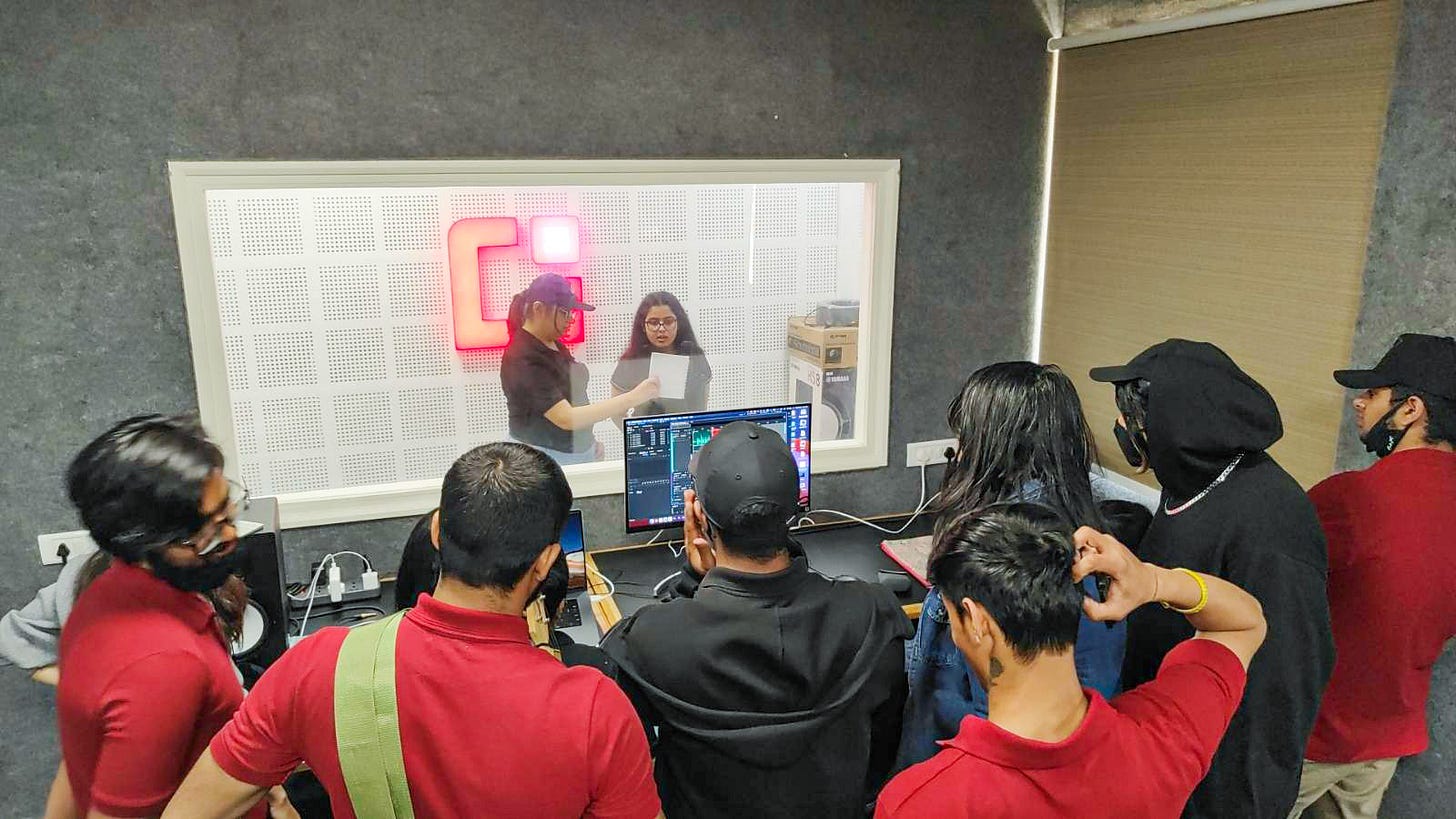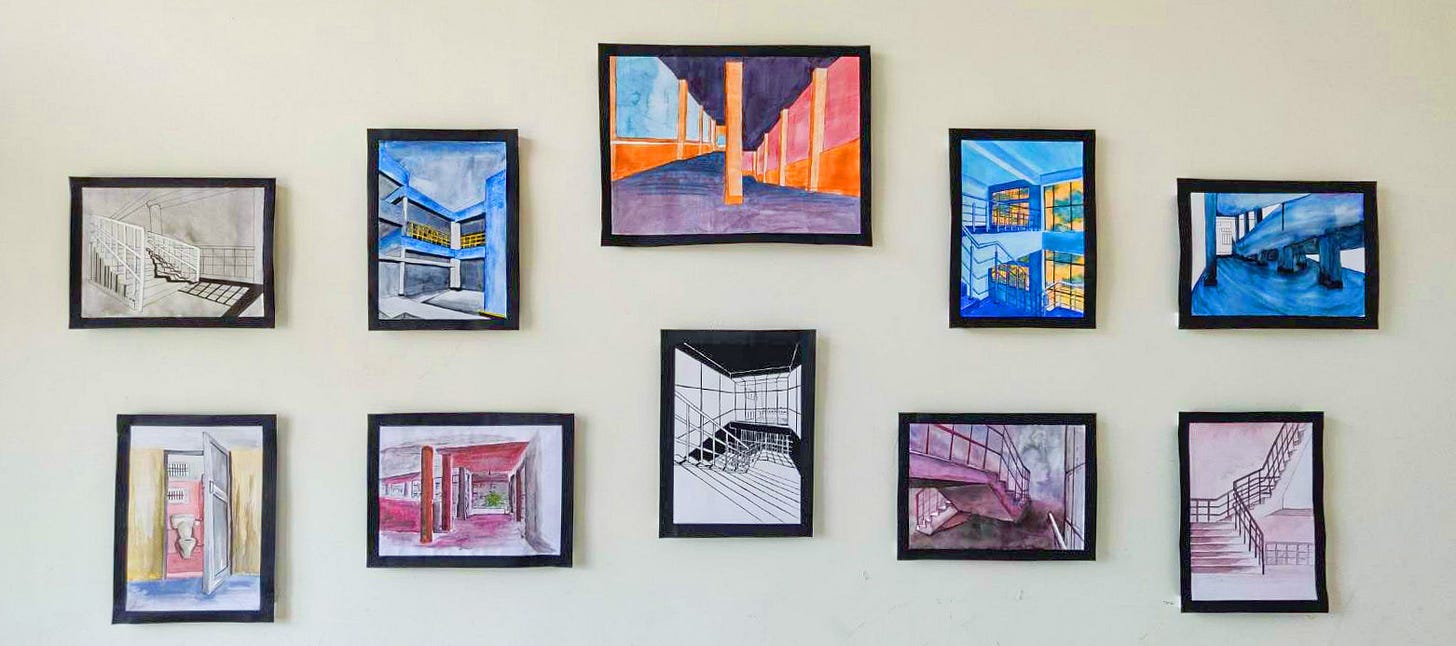How do humans process memory, space and sound?
A workshop on Space and Sound conducted at National Institute of Design, Haryana and Chitkara University.
Earlier this year we were invited to be a part of the Electives course at the Visual Communication Department at Chitkara Design School in Chandigarh. We have been associated with the department for the past few years, and we oversee their Film Semester every year. For the elective, we proposed a ‘Space and Sound’ module, which would be an exploration of the link between memory, space, and sound. This module was developed by A Bhaskar Rao and Shridhar Sudhir back in 2019 when we took the same module at the National Institute of Design, Kurukshetra. The idea of this blog is to outline the course design and the brilliant work put out by the students as a record and as well as a blueprint for anyone interested in conducting a similar course anywhere in the world!
The module is for two weeks, divided into two one-week sections, and at the end of each week we put up a display/installation of that week’s work. The first week we give the students one assignment per day, and we don’t tell them what the final display would look like. This week is the ‘subconscious exploration’ week, where with each assignment they are delving deeper into the inter-relation of space, sound, and memory. The second week is the ‘conscious exploration’, where we tell them exactly what the display is going to be like, and they work with the brief in mind as they design the experience of the display.
For the first week, we gave them four assignments. The first was to sketch out a space at their homes/hostels or anywhere on their college campus which held a strong emotional connection with them. This was to be done on an A3 sheet and then photocopied so that everyone had 3 copies of the sketch. Then we told them to paint the three sketches - once while listening to the organic sounds of the space itself, the second while sitting in the same space and listening to their favorite song on headphones as they painted, and the third while listening to a soundtrack that we provided. The idea behind these exercises was for them to tap into their own emotions with the space and how they change under different impetuses, using the abstract medium of color.
The second assignment was to remember a sound that they related to a person or a memory from their past. They had to think about this person or memory and write a small poem about what they felt or remembered. As there were students from different regions of the country, they were free to use whatever language they were comfortable in. Once they wrote these poems, they were given two assignments; the first was to write this poem on an A3 sheet using expressive typography, and the second was to record this poem in their own voice, along with the sound that they originally derived the memory from playing in the background.
On the final day of the first week, we told everyone that there would be a display of all the assignments in one space. The paintings were put on walls with a laptop playing the sound that the students were listening to while painting and people could walk up to the wall and put on headphones as they viewed the paintings. At Chitkara we asked everyone to put up QR codes of the songs they were listening to, and people could scan the songs and listen to them on their earphones as they observed the paintings.
The poetry that was recorded was mixed together and played on speakers inside the exhibition space. The idea was that the voices of the students and the sounds that triggered their memories would find emotional resonance with the people visiting the exhibition, and the expressive typography was displayed, with their English meanings, for people to read.

This first week tried to build on our subconscious emotional understanding of sound and memory, and when brought together as an exhibition created a multi-layered abstract exploration of how humans perceive them. For the second week, we divided the class into groups and gave them an ambient sound as a trigger. For the students of NID Kurukshetra, this sound was a thunderstorm. For Chitkara students it was the hustle and bustle of an old North Indian city, going about its business. The students had to imagine a space while listening to these sounds, and then create two characters within that space and write a situation that the characters find themselves in.
The two spaces imagined by the students at Chitkara University were - a brothel room in old Delhi and a bench outside Ghaziabad Railway station. Here they situated their characters. The first - A young man wakes up in the brothel room, where he is left by his friends to be “made a man”. Here he has a conversation with the sex worker, which leads to a beautiful moment of companionship. The second - An old homeless man is gasping for his last breaths lying on a bench outside Ghaziabad station, lamenting about his life to his dog, and all the missed opportunities he had to appreciate his life.
The students then had to create the ‘set’ - the space of the characters - in minute detail, with every decision coming from an understanding of who these characters are and how the space would reflect them. Then they had to record all the sounds that the characters would make in the situation, everything down to the soft clanging of the sex worker’s bangles as she did her makeup to the rustling of the chains of the dog. Then they recorded the dialogue and created a soundscape of the scene.

The challenge was that the characters would not be present in the scene; they had to be represented by their sounds alone. To add to their presence, the students were told to strategize on the placement of the speakers within the space, so that they could design the sound in a way that would also give a sense of placement to their characters, and they can play around with how the character is moving in the space.
The final output came through beautifully, and the people who came to the exhibition could feel the ‘presence’ of the characters in the space through the set design and sound alone. There was almost a sense of reverence for the imaginary character’s space as the people interacted with the exhibition. I have edited together a video with images of the space and the soundscape the students created. The best experience would be to watch it with headphones on.
We wanted to share the experience of designing and creating this course, as well as the brilliant work done by the students. We hope that other people would take the seed of this idea and explore it with other students/people in other institutions/programs, and if they add/change/evolve anything, they could write to us or comment on this post so that we (and others) could learn from the same!
You can check out more of A Bhaskar Rao’s aural work on his soundcloud, and an earlier experiment on migration. You can also buy his latest book of poems, Khayal Darzi on amazon, flipkart, and directly from the publisher.
The writer Shridhar Sudhir is an independent filmmaker, academic, and artist and the founder of Buddhijeev Studios. You can check out his website here.




